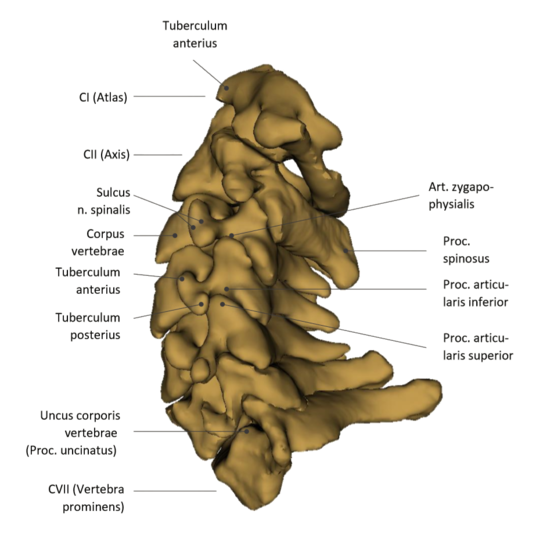Cervical spine
The cervical spine forms the uppermost and most mobile part of thespine. It has seven cervical vertebrae. The 1st and 2nd cervical vertebrae (atlas and axis) clearly deviate from the basic form. The two cervical vertebrae together with the base of the skull form the upper and lower upper cervical joint (bicondylar joint).
The connection of the occipital bone with the first cervical vertebra is the atlantooccipital joint. This connection is surrounded by a loose joint capsule and is held in place by ligaments between the occiput and the anterior and posterior atlas arches. This results in a range of motion of the joint of about 20° (forwards and backwards).
The atlantoaxial joint consists of three separate joints:
- the first between the tooth (Dens) of the axis vertebra, the anterior arch of the first cervical vertebra and a ligament (Ligamentum cruciforme atlantis) in the atlas
- the second and third joints are located left and right between the joint surfaces of the first cervical vertebra and the axis vertebra
Thus the atlantoaxial joint together with a narrow joint capsule allows a freedom of movement of 30° to the right and left.
Die restlichen fünf Halswirbel besitzen ein relativ kleinen und annähernd quaderförmigen Wirbelkörper mit einem großen dreieckigen Foramen vertebrale.
Die Randflächen sind sattelförmig geneigt und erheben sich an den kranialen Flächen (Procc. uncinatus), die allerdings erst im 10. Lebensjahr sichtbar werden.
Der siebte Halswirbel wird als Vertebra prominens (vorstehender Wirbel)
bezeichnet, da sein Dornfortsatz ein wenig weiter heraussteht als bei den anderen sechs Halswirbeln. Daher dient er auch gut als Orientierungspunkt.
Durch die Querfortsätze der Halswirbelsäule verlaufen die Vertebralarterien (Arteriae vertebrales), sie stellen zusammen mit den inneren Halsschlagadern (Arteriae carotidiae internae) die Versorgung des Gehirns mit Blut sicher.
Die Halswirbelsäule zum freien Explorieren
| mit Annotationen | ohne Annotationen |
<segmenter border="1">https://dornheim.cloud/index.php/apps/segmenter/embedding/view?identifier=HQBtIMtKntIU</segmenter>
weiterführende Links
